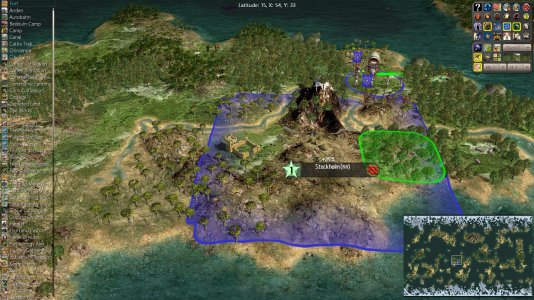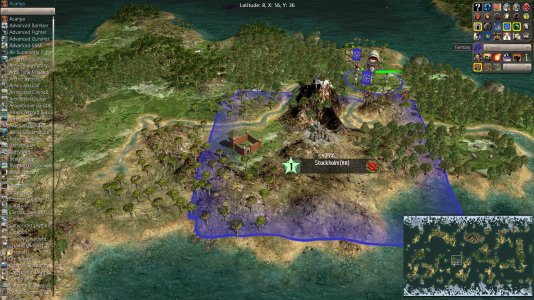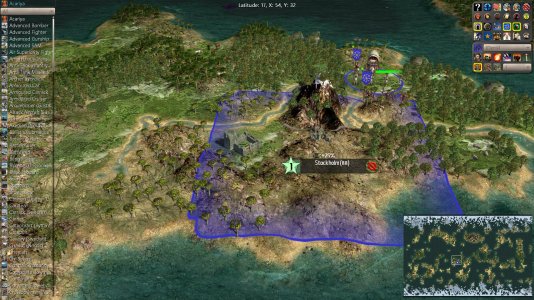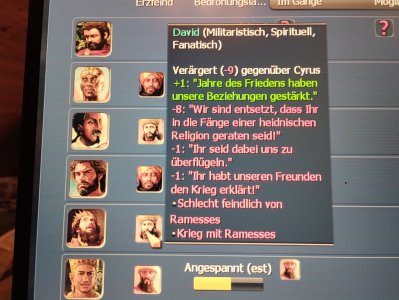Hmm. If the goal is to prevent early rush of an AI, what if AI's started with a weaker version of the immobile defender barb cities get in world maps? As it is, the AI is its own worst enemy because they fail to use what you give them for defense for that purpose. A unit that can't be used for any other purpose than defending its initial plot may be an appropriate solution.
That is not a bad idea in itself, but feels a bit forced to me. It kind of works with the current balance anyway.
This mod has the best graphics then any other mod Ihave played. Buildings
Improvements and especialy units are amazing. Only 1
Improvement stands out. Fort. For ancient and medieval eras it is fine, but in renessainse industrial and modern eras it looks obsoleted on map. In industrial era more suitable model for fort can be something like star fortress, and in industrial/modern eras it could be bunker or air base. I dont know is it simple to make such changes or it is complicated and needs a lot of time?
Your links don't point to anywhere in particular, but I can guess you're speaking about Forts. Making them prettier was in the back of my mind for quite a while now. I may just do that.
Also i find Minor bug - if you and another civ have "Slavery" civic and somehow on teritory of second civ you capture a slave (lets say slave rebellion in his town,its your turn and you attack these slaves for free EXP enslaving them again) - you can preview what another civ build using button "Sacrfice slave" - as you would normally do in your city. Using that - you can just send 7-8 slaves (in ancient era) and use them as free town view of another country (No spy points spending)
That's cool! I'm not sure if I need to specifically fix it, it's quite niche and you have to go out of your way to exploit it.
- The stock exchange tech has global trade has a requirement, but it also requires classical economy which requires global trade already. Glancing at the tech tree in the Renaissance, the tweaks that have been made around tech requirements, tech names and tech effects appear promising. I will have to play more to comment more.
Thanks, yes, that's an oversight.
In which function do you think the issue happened?
I believe it was trying to do a turn for UNITAI_SETTLER_SEA merchantman "loaded" with the settler, worker and a military unit, but said settler had already changed its mind and was trying to wander off on foot (I know it does wander off on foot if you reset or delete the ship), so the call to check the cargo resulted in a NULL call for a unit no longer there. It's rather easy to pinpoint the exact lines of code that led to the crash (you build a debug dll, let the save crash, save a full dump and then simply load it into VS and debug natively), but much harder to determine how they got there. So the cause is a conjecture on my part, but the result was definitely a null call for a cargo unit.
That's not true anymore since you moved Warbands to Weapon smithing.
Oh yeah, that's true. I loath to add 6 new unit varieties though, so I might just require Weapon Smithing for Mining.
- The English frigate has white masts.
And so does their SotL. They would actually paint masts white or yellow:

Not in all cases, so wooden-coloured masts would also be accurate, but white masts aren't an inaccuracy per se.
- The "Royal" Canon for England appears to be a siege piece following a Vallière template, not a field gun. While I understand that the "cannon" unit functionally represents several classes of siege weapons in use during its era, it seems that a field piece is more appropriate to represent with a mobile unit, especially considering that emplaced artillery already separately exists (though admittedly only for defensive purposes in siege warfare, and I don't think we have any distinctive units for it either). I may be ignorant and this is actually emblematic of field pieces, but the unit model resembles a 24 pound Vallière, which would have been notoriously unwieldy and immobile for battlefield purposes. As always, I'd enjoy learning more if I am mistaken about this.
Since I updated the cannons in recent SVNs, most flavour cannons essentially look the same, and I'd say they pre-date the de Vallière system; if we're using the French nomenclature, I'd place them as Grande couleuvrines of the pre-Vallière Calibres de France system or as demi-cannons (not in the British naval sense) of more generic nomenclature. Using a heavier cannon was a deliberate stylistic choice on my part, to better visually distinguish them from both earlier bombards and later Napoleonic pieces, but those still match pieces that would be used in field in the pike and shot era.
- The English man-at-arms and foot knight look exceptionally cool. The houndskull visor is intimidating and ornamentally "late-medieval," while I am also surprised that I believe the Bardiche is the only other halberd-wielding unit in the whole game.
There is also a halberdier Spain uses, but yeah, polearms in general are underrepresented, not in the least because I have to create new models from scratch or find where to convert them from.
- The English knight, however, does still wield a sword at any rate...

Intentional?
Laziness. This is a simple retexture of the vanilla Knight that I didn't update. If I were making a new one from scratch now, it would have a lance or an axe/mace. Brits were quite fond of axes in late medieval era, more so than their continental counterparts.
- The English ship of the line has an insignia painted onto the sails. Was this still in practice during the reign of George III when the Age of Sail was in its culmination?
Not really, no, it's more to ensure stylistic consistency with the vanilla unit and for easier visual identification.
- And, finally, a gameplay-contingent question from a stray thought that occurred to me: how about disabling the ability to heal ships in the ocean? After all, it both doesn't really make sense (as mid-sea repairs were always rudimentary and done with stocks and supplies brought aboard already, otherwise fully dependent on access to fresh materials on a coast somewhere) and also too convenient in gameplay, where you can easily sail off into the ocean in a random direction unlikely to be pursued. While my previous request to have early ocean-going sailing ships have a risk of sinking at sea was refused on the basis of how it could disrupt AI pathfinding, this would somewhat make exploration harder, as retreating from pirate-infested coastlines in the New World and then just healing in the ocean for several turns and then returning would no longer be possible.
Would require messing with AI a lot.
EDIT: The axeman appears to have been moved to weapon smithing anyway? Surely that is an oversight, given the comment that they were deliberately supposed to stay with bronze working.
Sloppy search-and-replace job from me, will fix.
A good start for everyone is, in my opinion, essential for a good game, so I would recommend that in the upcoming version and forward, a value is set to "what is needed", so that the AI prioritizes the early defense with a palisade.
I don't really see them suffering as they currently are.
In fact, this is a typical "saker." That is, it is a field gun with a caliber of less than 6 pounds (5.25). Just guns "up to Griboval" are, in principle, "abnormally" long-barreled compared to guns familiar from the Napoleonic wars, etc.
For, firstly, the normal technology of drilling the cannon barrel channel (horizontal machine) appeared only in 1734. Before that, the trunks were overwhelmingly cast with a ready-made channel. With the precision of the casting, it was all very sad.
Similarly, everything was very bad with standardization, even in cases where it was possible to carry it out.
As a result, "individualistic" barrels met with "independent" ammunition. The gaps were large, and the efficiency of the gun was low. As a result, the only option to achieve normal ballistic characteristics were large charges of gunpowder (from where the thick breech) and long barrels. At the same time, due to the unpredictability of the relationship between the barrel and ammunition, the range and length of the barrel had to be done with a margin.
Valliere received drilled guns and standardized them, but the design remained almost the same. There is a rational explanation for this (he wanted to preserve the siege capabilities). However, among Valliere's brilliant ideas is the complete eradication of cap loading. Therefore, it is quite difficult to determine where Jean Florent's rationally stupid ideas end and where his irrational stupidity begins.
Then, yes, the Lichtenstein and Griboval systems appeared and the guns acquired their usual appearance. At the same time, the siege artillery retained almost the same design – precisely because it still required large charges and high core velocity / long barrel.
You're describing the one that's used in the release version (which was indeed a saker) so the two of you are actually talking about different pieces. The one he was originally describing is from the recent SVNs and looks like this:
I can add that in my opinion ability to heal on coastal tiles should have only sailing ships. Iron ships can be repaired only in cities (maybe forts also). I can hardly imagine modern battleship taken damages in battle and repearing itself just near coast or in open sea. In that case promotion 'hospital ship' (promotion for additional heal for ships, I dont remember exact name) become unusable.
Again, a lot of AI recoding would need to be involved.
I put one barbarian fort in every AI capital on Huge earth map, because in another case barbarians elimanate half of all civs before reaching ancient era. especially suffer civs living lonely far away other civs: vikings, russian, india, mongols, china, khmer, korea, mali. they die at the start of the game in 100 % cases.
also I give barb forts high lvl but low xp. It prevent forts from getting promotions from battles with barb and other AI.
What settings and version are you playing at? That definitely doesn't match my experience.


 Intentional?
Intentional?







